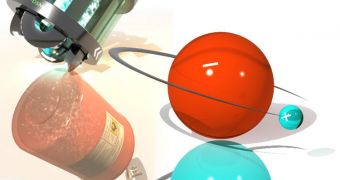Experts with the ALPHA Collaboration at the European Organization for Nuclear Research (CERN) have successfully analyzed the internal structure of an anti-atom for the first time ever. Their study could open up entirely new avenues of research in science .
The spectroscopic measurements were conducted on an antihydrogen atom. In order to do this, the team had to use the antimatter trap at ALPHA. Studies of this type could theoretically reveal more of the differences between matter and antimatter.
Scientists with the US Department of Energy's (DOE) Lawrence Berkeley National Laboratory (Berkeley Lab) collaborated with colleagues around the world in the construction of the antimatter trap device, which the research team used to probe an anti-atom for the first time ever.
Details of the research appear in the latest online issue of the top scientific journal Nature, and are also scheduled to be published in an upcoming print issue of the magazine. The researchers say that ALPHA was the first collaboration to ever capture an antihydrogen atom, back in 2010.
This anti-atom is made up of an antiproton and a positron. The latter is the positively-charged equivalent of an electron. Holding on to such a frail construction is no mean feat, so the team needs to use magnetic traps. In these devices, neutral atoms are trapped using their magnetic moments.
During the most recent experiments, ALPHA scientists were able to use this advanced device to capture hundreds of antihydrogen atoms inside a strong magnetic field. The next step was to expose the trap to large amounts of microwave radiations, which changed the spin of positrons.
“In hydrogen, the interaction of the spin states of the electron and proton splits the ground state (the atom’s lowest energy) and is known as hyperfine splitting; in astronomy, hyperfine splitting is the source of the signature 21-centimeter emission line of hydrogen,” a Berkeley Lab press release states.
“To measure the hyperfine structure of antihydrogen we tune the frequency of the microwaves. Our newest experimental apparatus is already under construction, and these initial experiments indicate that we’ll soon have the techniques to make precise measurements,” adds Jonathan Wurtele.
He is a member of the Berkeley Lab Accelerator and Fusion Research Division (AFRD), a University of California in Berkeley (UCB) physics professor, and also a member of the ALPHA Collaboration.
Scientists now need to continue their studies of antihydrogen, in order to determine whether the atom is indeed exactly the same as a baryonic hydrogen atom. If that is not the case, then the scientific community will most definitely experience a great shock.

 14 DAY TRIAL //
14 DAY TRIAL //